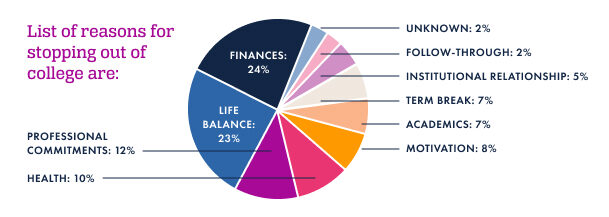5 ways to support adult learners that make a huge impact

How can colleges and universities better support adult learners? The following strategies have helped to engage, enroll, and support nontraditional students in meaningful ways.
It’s no secret that returning learners over the age of 25 face more life challenges than the average 18-year-old, first-year student. Transitioning into the classroom after years of balancing personal commitments and job responsibilities can be intimidating–especially for first generation students new to navigating higher ed systems.
When done right, student support services not only help fill knowledge gaps, but ensure returners are on track to meet their education goals over time. To avoid the most common challenges adult learners face, holistic support beyond academics is key.
Steve Herendeen, Vice President for Enrollment Management at Indiana Tech, says, “While providing career-focused and relevant programs are important, the adult learner also needs other support to help them navigate their educational pursuits as they deal with various life challenges. Indiana Tech continually assesses the needs of adult learners, in and out of the classroom, and innovates around their needs.”
“While providing career-focused and relevant programs are important, the adult learner also needs other support to help them navigate their educational pursuits as they deal with various life challenges.
Indiana Tech continually assesses the needs of adult learners, in and out of the classroom, and innovates around their needs.”
— Steve Herendeen
Vice President for Enrollment Management at Indiana Tech

To build better experiences for their adult learners, ReUp partner institutions have implemented the following best practices help adult learners overcome their most common barriers to completing their educational goals:
1. The challenge for students: Finding the right school, quickly
Short on time, and overwhelmed by online information, adult learners thinking about re-enrolling are looking to your website to guide them in the process. Admissions pages, therefore, can very quickly signify if your institution is a good fit.
Take a moment to review the admissions, support, and community pages on your institution’s website. Does your site have a readmission page? Can adult learners see themselves—their challenges, needs, and aspirations—represented on the screen? Is your messaging welcoming to nontraditional learners, conveying a sense of belonging, in addition to providing the necessary transactional information?
Best Practice: Demonstrate that you understand students’ needs
As is often true with all marketing and communications, it’s important to deliver relevant information at just the right time. The real challenge? Adult learners can take several months to several years to decide when and where to return to their studies.
Returning learners are not a monolithic group, and may require different types of support to be successful. It’s important to communicate that you understand their needs and are equipped to deliver—whether they’re a working parent, veteran, community college student, or have other unique obligations outside the classroom.
For example, ReUp initially engages with stopout students through SMS text messages and email to gauge what obstacles they currently face in returning, offering support before promoting academic programs. Institutions, too, should emphasize that they offer the tools to succeed before they promote specific educational pathways.
Lehigh Carbon Community College (LCCC) is a two-year institution in eastern Pennsylvania with a growing adult learner population. To highlight that returning students will have guidance and support in navigating re-enrollment and staying on track, LCCC has highlighted ReUp Success Coaches on its Admissions page.
2. The challenge for students: A difficult application process
Outdated processes catering to traditional students can create huge stumbling blocks for adult learners that are pressed for time. In 2022, 25% of students surveyed by Sallie Mae said that they did not submit a FAFSA because the application was too complicated.
The equity gaps that separate adult learners from typical first-year students can become more pronounced because of such processes—for example, requiring students to give inaccessible information, such as the financial situation of their parents.
Best practice: Remove the friction from applying
Is your institution creating friction for adult learners ready to apply? Sometimes the devil’s in the details. Asking for too many required forms, or making it difficult to apply online and in a mobile-friendly format, could be turning many prospective learners away.
Consider auditing your application process, and identifying any barriers, on a routine basis. Streamlining the admissions process is also highly beneficial for admissions teams, as they can eliminate redundant information and reduce confusion on an administrative level.
Some colleges and universities waive an application fee—an easy win for some institutions that are unable to commit to larger financial incentives. Streamlining admissions requirements isn’t just about financial incentives, however; it also means recognizing that time is a barrier. That’s why some institutions extend deadlines closer to the date that the next term begins.
Some institutions, like Middlesex Community College (MCC), offer assistance filling out the FAFSA (for MCC, it’s a 90-minute session with a student). ReUp Success Coaches also help students navigate the admissions process, providing guidance and support every step of the way towards enrollment.
Excelsior University, a private, distance learning institution in Albany, NY, streamlined its admissions process by removing testing requirements for all applicants (except in the case of their nursing program). They also offer free transcript reviews and other supportive services.
3. The challenge for students: Finding a flexible program
Online and blended learning programs are highly desirable to adult learners balancing work, family, or other obligations with their studies—and for good reason. According to the College Board, the average student at a community college in the academic year 2022-2023 paid $1,870 in commuter fees.
Today, even more remote learning options have been made available as a result of the pandemic, yet many of these new opportunities aren’t on the radar of adult learners.
Best practice: Highlight program choice, flexibility, and speed
Beyond remote learning options, adult learners may not be aware that there are other ways to make education fit alongside other commitments in life. To assist busy and working students, many institutions provide guided pathways, accelerated learning programs, and multiple re-entry terms to make it even easier for learners to get back on track.
But it’s not enough to simply create flexible programs for adult learners and anticipate that there will be an immediate response. It’s up to institutions to connect the dots, guiding learners to the right program that aligns with the student’s lifestyle. To support this, ReUp coaches strive to understand what learners value most, whether that’s remote learning, speed to graduation, hybrid or flexible programs, or the opportunity for valuable experiences outside of the classroom.
The University of Idaho created a popular online Bachelor’s of Business Administration program, for example, that awards a certificate after eight weeks of study, giving students the flexibility to complete coursework that’s 100% online. The only requirements are that students complete four skills-based certificates to earn the degree. Each certificate focuses on real world business practices, cases and experiences, and is designed to help students immediately apply lessons from their coursework to their care
4. The challenge for students: Affording higher education
Filling the education gap and making learning accessible to all often means meeting students where they are. Without a doubt, online and blended learning programs are highly desirable to adult learners balancing work, family, or other obligations with their studies.According to ReUp data on adult learner motivations, financial resources are the most common reason for stopping out of college (24%). For many students, limited finances and personal commitments are deeply intertwined, creating an outsized impact on students’ prospects of degree completion.

Best practice: Emphasize financial support to enter and stay
Not all institutions are able to offer major financial incentives to adult learners and returning students. But there are solutions both large and small that can make a significant impact on making higher education more affordable. Just a few of the financial assistance programs that ReUp partners have provided to their learners include:
- Scholarships specifically designed for returning students and adult learners.
- Promise programs (typically statewide) that include adult or part-time learners (for an example, see New Jersey’s Garden State Guarantee)
- Completion grants, or targeted assistance at the end of a program.
- Emergency grants (typically small-dollar)—for some students, there could be hesitation around accepting these funds, so it’s important to be sensitive to the way they are communicated.
- Basic needs assistance, despite the stigma. Food, housing, and transportation all deeply impact adult learners’ ability to persist. Even if your institution isn’t able to provide additional assistance directly, you can still connect students to community resources.
- Financial literacy and wellness programs—these can enhance students’ self-efficacy, reducing anxiety and improving students’ quality of life
Kalamazoo Community College in Michigan offers a debt forgiveness program for returners with existing debt at the institution. The message this sends to adult learners from economically disadvantaged backgrounds is clear: don’t let debt hold you back from achieving your academic goals.
5. The challenge for students: Seeing the ROI of their education
The cost of educational advancement can be very concerning for returning students and adult learners, many of whom stop out because of financial burden, as previously noted. In the US, the average federal student loan debt per borrower is $37,338, according to the Education Data Initiative. For those who take out private student loans, debt averages at $54,921.
With tuition costs showing no signs of going down, it’s important to communicate the clear value of students’ investment. As Texas A&M University Corpus Christi student Hannah explained to ReUp: “When I became a junior, and I was still in this place, I felt scattered. I became frustrated with paying a substantial amount of of money, to barely pass classes that I wasn’t sure were leading me down a path that I wanted to be on.”
“When I became a junior, and I was still in this place, I felt scattered. I became frustrated with paying a substantial amount of money, to barely pass classes that I wasn’t sure were leading me down a path that I wanted to be on.”
— Hannah
Texas A&N University Corpus Christi Student
Whether students are returning to their studies to advance in their current career or explore a new one, institutions have an opportunity to explain how they’ll set adult learners up for continued success beyond the classroom.
Best practice: Show how you deliver value
How can institutions show value effectively while managing students’ expectations? Data and relevant information–in some cases at a granular level–is key. It starts as early as the pre enrollment stage, where communicating recent alumni success stories and career outcomes related to various fields of study can offer valuable insights for students.
Other data that savvy adult learners may be searching for include:
- Time to degree for working adults and students who are parents or caregivers
- Diversity of students, faculty, and staff
- Average percent of transfer credits accepted and applied to a program
- Employer partnerships and local labor market outcomes by field of study
Another often overlooked piece of important information to provide: internships, especially paid or subsidized, that can give adult learners just the opportunities they need to lay the foundation for a rewarding career.
At Texas A&M University—Commerce (TAMUC), a public university in Commerce, TX, career development opportunities are integrated into the student experience through their “HireaLion” program. This includes connecting employer partners to its students through work placements such as virtual or micro-internships, providing career coaches and career preparation services.
Whether your institution needs to focus on better communicating its ROI, or discover which types of support programs it can offer adult learners, ReUp can provide the data-driven support that’s needed to more effectively engage with and support adult learners.
As the tech-enabled solution designed exclusively for the adult learner population, ReUp helps institutions connect students to the information, support, and guidance needed to succeed in completing their degree. In turn, creating inclusive and nurturing environments that significantly impact educational outcomes.
Want to see high impact student support services in action?
Hear directly from ReUp partner Kalamazoo Community College about how they created change to attract and enroll more adult learners, watch the webinar: “Demystifying the Adult Learner: The FAFSA Is Not Enough”:
Let’s start the conversation
Schedule a call with a ReUp team member to learn more about what a ReUp partnership could do for your institution.